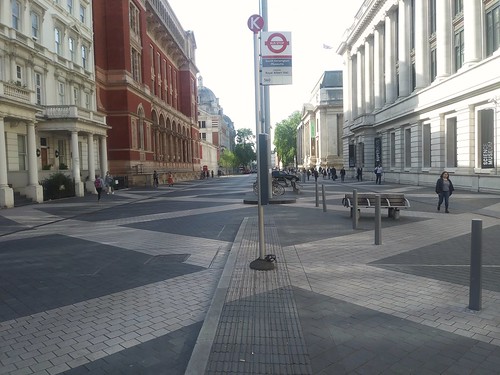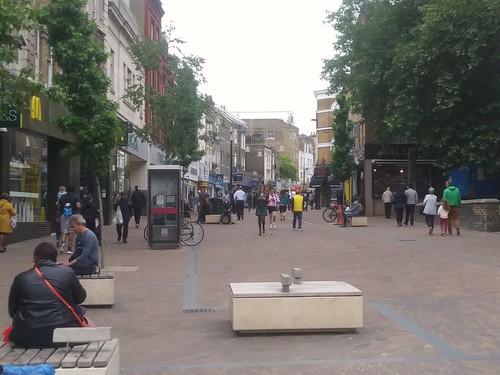Sadly, DC won't show so well during the Baseball All-Star Game
 Sports mega-events as revitalization triggers. Yesterday I was reading the book, Wish You Were Here: The Branding of Stockholm and Destinations, authored by Julian Stubbs.
Sports mega-events as revitalization triggers. Yesterday I was reading the book, Wish You Were Here: The Branding of Stockholm and Destinations, authored by Julian Stubbs.His branding agency, Up There Everywhere, was the sponsor of the International Place Branding Conference event held earlier in the month in Liverpool, (to which I received a complementary registration, and my trip was also sponsored by a number of donors to a GoFundMe campaign to help pay for the trip).
The book isn't a primer or textbook, it's more of an outline and motivator aimed to get interested parties thinking and "thinking right" as it relates to place branding, and the impact of tourism on the local economy both in terms of visitation but also attracting new business and new investment to further strengthen the local economy.
There are a bunch of case studies, not in super depth, for cities like New York, Barcelona, and Liverpool, which show the range of responses that are possible.
One point he makes is that cities need to invest more money and time into the creation of events and festivals, but he also discusses mega events like the Olympics and the World Cup. Unfortunately, for many countries--like South Africa for soccer, and Greece and Brazil for the Olympics--such events don't work out. I have written about this quite a bit:
-- "Big sporting events (World Cup/Olympics), economic development and trickle down economics," 2014
-- "(Not enough time for a) 2024 DC-Baltimore Olympic Bid (to make sense)," 2014
-- "New Year's Post #3: More thinking on "return on investment" from different types of sports facilities and DC, and an Olympics in DC," 2015
-- "Rio Olympics," 2016
-- "Revisiting the Olympics selection process," 2017
Megaevents as end points vs. beginning points. Barcelona is always given as an example of how to leverage a mega event like the Olympics successfully, while reading the book, I was thinking that most places really get this wrong because they see the event as the end game, when really it is the beginning, and a component, albeit a major component, of a wide ranging plan.
Basically, it's part of a "Transformational Projects Action Plan," an approach I've been developing for awhile.
Because for countries without the necessary infrastructure it is so costly to build it--South Africa estimated the cost would be $300 million and instead it was $3.5 billion--and because the event owners--FIFA and the International Olympics Committee--expect the host country to pay for everything, a very serious and objective calculation of the potential return on investment needs to be created, and some places should walk away.
Places off the beaten track and hard to get to, South Africa and Brazil, or easier to get to but not particularly wealthy like Greece, maybe should walk away.
In any case a very detailed business plan needs to be developed to ensure that economic benefits are reaped for many years after the event to make it worthwhile. The plan needs to be in place for the years in advance of the event and for at least one decade afterwards.
E.g., with the 2012 Olympics in London over now for more than 6 years, they are still dealing with some of the sites and redevelopment plans.
 Half Street SE, looking toward N Street. WBJ photo.
Half Street SE, looking toward N Street. WBJ photo.Baseball All Star Game in DC. This comes up with the Major League Baseball All-Star Game, which will be held in Washington next month.
The Washington Business Journal writes in "Unfinished business: It's All-Star time, and Half Street is one sad construction mess," that the area around the stadium looks pretty gnarly.
Last summer, I wrote about this, in "Urban design considerations for the area around Washington Nationals Baseball Stadium in advance of the 2018 All-Star Game."
Although I had been thinking about this problems since Opening Day in April 2017.
The entry makes the point that the streetscape around the Washington Nationals baseball stadium needs to be significantly improved to strengthen its urban design and placemaking qualities, especially since in July 2018 the Major League Baseball All-Star Game will be held there, to mark the 10th anniversary of the stadium. (This is discussed in depth in the piece.)
While that's an important date for the team owners, for the city, it would have been better for MLB and the Washington Nationals to have waited until the various construction projects were completed.
Special use permits should be required for such events, to ensure the best possible long term results from holding the event. These kinds of events should require special use permits, so that localities have some say in when they are held. In the case of a July 2018 All Star Game in DC, DC should have said no, the area wasn't ready.
Graphic from TDS & Associates.
Destination readiness: it ain't there. In tourism, there is an important concept called "Destination Readiness." As the WBJ article points out, the area around the baseball stadium isn't ready.
The Navy Yard district is getting there. The soccer stadium is opening late next month, on Saturday July 14th, one day before the start of All Star Week.
The Wharf opened its first big section last fall, with another under development.
Imagine the impact of these sub-districts being knitted into one big destination, with all the necessary connections and design treatments.
They'll be at that point, in maybe five more years, and 2023 would have been way better for the City, although maybe not for the Washington Nationals, to have this event.
An urban design and placemaking plan. Ideally, simultaneously with the construction program, there should have been an urban design and streetscape plan -- there are some plans but not as comprehensive as they should be-- and a ground floor plane and retail development program for the buildings leading to the stadium, so that it would be a great experience, instead of an office district + Potbelly vibe.
Besides models at Fenway Park in Boston--more as a gateway to the stadium, it's not a good example of special urban design treatments--and Camden Yards in Baltimore, the design of the streets in the area should be something like the design of Exhibition Road in London.
Although to my taste the road still is dominated by cars, albeit not that many, even as the design of the road and sidewalk is the same and the road can be closed for special events.

A pedestrianized section of the road extends from the museum district to the area around the South Kensington Underground Station.

 Google Map of the area around Nationals Stadium.
Google Map of the area around Nationals Stadium.In the Washington Nationals stadium area, such a treatment should be provided for all the streets and sidewalks in an expanded "stadium district" comprising Half and Van Streets SE between M and N Streets, N Street in front of the stadium. Maybe even 1st St. SE too, and some of the other streets like N Place.
Pedestrian zones for DC. Note that separately, inspired by my recent trip to Liverpool and my experience a few years ago in Essen ("Pedestrians, cars and the city: from opposition to cohabitation", Metro Politiques)," I am preparing a piece on creating short pedestrian "zones" in various places in Washington.
During the 2010 ThinkBike exercise led by a delegation from the Netherlands, one of the leaders was very surprised that DC didn't have any pedestrianized zones.
I was nonplussed. Why should we? Most pedestrian malls across the US have failed, etc.
But now I see that I was looking at this the wrong way.
You can have large pedestrianized zones like they do in Essen or Liverpool, so that they still function as the commercial and retail heart of the city--and that would be the ideal--or you can have short strips "here and there" where the conditions are totally favorable.
In most places where pedestrian malls failed, it was because they were too big relative to population density and activity.
It's best to start small, where you know you'll succeed, and build from there.
London has a number of pedestrian zones, but I don't think big districts like Liverpool or Essen. One I happened across was Mare Street in Hackney. It had the look of being there for many many years, but it turns out it's only a few years old. It's short, a couple blocks, but it works. And the borough is working on extending it, now that it is proven.

It helps that it's by the Hackney Central London Overground Station and one of the borough's many shopping districts.
That's the idea I have for here. A block or two here and there, in various places across the city. Not many, fewer than 10.
Labels: infrastructure, mega-events, special events and programming, sports and economic development, tourism, urban design/placemaking, urban revitalization



2 Comments:
the street will be redone for 2020:
https://www.bizjournals.com/washington/news/2019/03/28/developers-plan-a-pedestrian-friendly-gateway-on.html
This article discusses how theme parks are adding festivals to build attendance, especially in what had been thought of as off peak periods.
https://www.ocregister.com/2022/01/11/niles-why-disneyland-and-other-parks-need-more-festivals/
"Why Disneyland and other parks need more festivals"
The point pertains to cities and sites and event planning/planning for seasonality more generally.
Disneyland and other local theme parks no longer believe in such a thing as an “off season.” Southern California’s theme parks remain open year round, and they want people coming in every single day.
With January bringing students back to school and fewer vacationers traveling, that means theme parks have to get creative with their programming to entice more locals to visit more often. Their response? Festival season. ...
The special entertainment, presentations, merchandise, food and drinks at these events are designed to provide annual passholders fresh reasons to come back, even if they already have been on every ride in the park. But these events also provide theme parks an opportunity to extend their appeal.
Post a Comment
<< Home